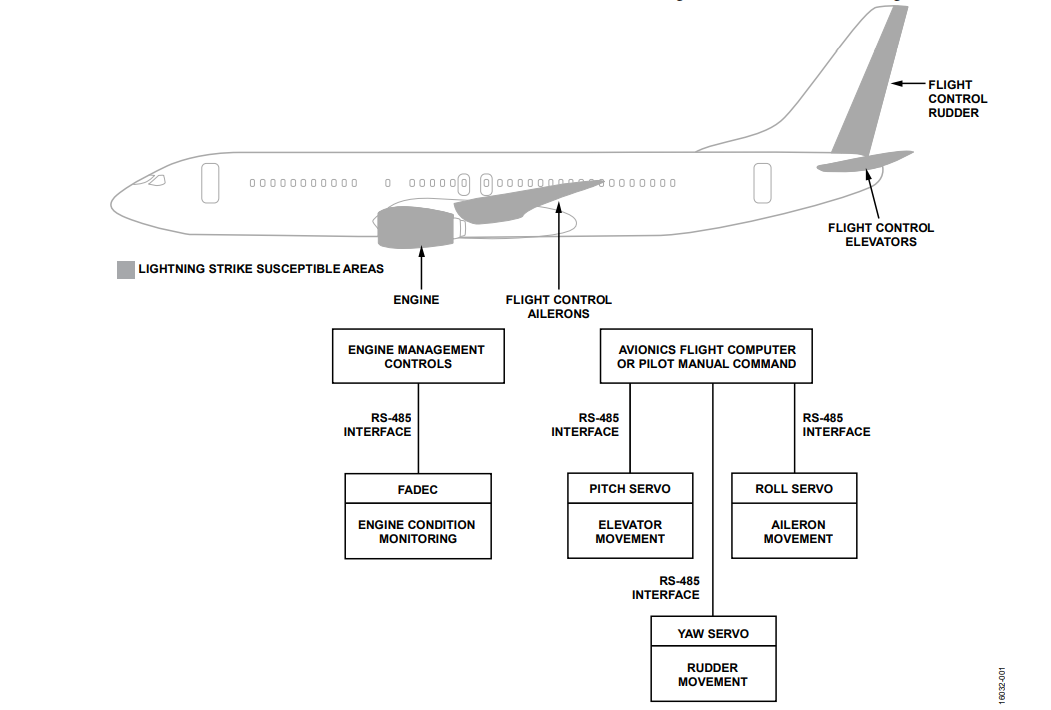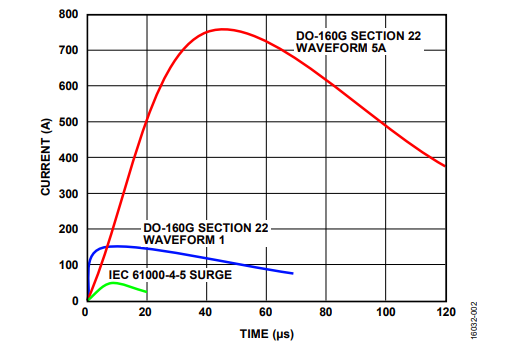AN-1468: Lightning Protection for Communication Interfaces in Avionics Applications
Introduction
Lightning strikes to jet airliners are common: about once every 1000 flight hours. The DO-160G standard, Environmental Conditions and Test Procedures for Airborne Equipment, is a standard for the environmental testing of avionics hardware. Many airplane manufacturers specify DO-160G Section 22, lightning induced transient susceptibility, as a requirement for critical systems, like guidance, radars, communications, engine control, and heat and air controls. Aircraft fuselage, wing and tail flight controls, wing tips, fin tips, engine nacelles, and landing gear are the areas most likely to be hit by lightning strikes.
Robust Communication Ports
Modern aircraft are designed with fly by wire systems for flight controls. Fly by wire means that inputs from either flight control computers or pilot manual inputs are transmitted electrically to a servomotor, which controls flight control actuators. Communication interfaces for these flight control systems can be implemented on an RS-485 physical layer. Communication interfaces for aircraft engine management control can also be implemented with an RS-485 physical layer. The full authority digital engine control (FADEC) systems installed on aircraft engines is responsible for monitoring temperatures, pressure, and fuel flow, among other parameters.
This application note describes Analog Devices, Inc., robust RS-485 transceivers for military and aerospace (MILA) avionics. The ADM2795E-EP is a 3 V to 5.5 V RS-485 transceiver with added robustness that reduces system failures when operating in harsh application environments, such as MILA avionics, for sensors, flight control actuators, and engine control.

Environmental Requirements
Lightning Indirect Effects
The DO-160G Section 22 lightning standard simulates the transient voltages and currents introduced into avionics as a result of the magnetic field generated by a direct lightning strike surge through the aircraft airframe (fuselage).
Table 1 shows that commercial aircraft typically require DO-160G Section 22 lightning protection between Level 1 and Level 4 for Waveform 3 and Waveform 4/Waveform 1. Aircraft equipment are divided into three zones, and each zone has an associated electromagnetic compatibility (EMC) environment. The most severe EMC environments are located in the Category A and Category B zones, which are areas of the aircraft that are not environmentally controlled.
| Equipment Category | Inputs/Outputs Category | DO-160G Waveform 4/ Waveform 1 |
DO-160G Waveform 3 |
DO-160G Level |
| Category A: Critical Equipment |
Power supply Signal: exposed area |
750 V, 150 A 750 V, 150 A |
1500 V, 60 A 1500 V, 60 A |
4 4 |
| Category B: Essential, Hazardous Equipment |
Signal: externally mounted (fuselage, wings) Signal: belly fairing (aircraft lower surface), radome (radar cover) |
750 V, 150 A 300 V, 60 A |
1500 V, 60 A 600 V, 24 A |
4 3 |
| Category C: Essential, Major Equipment |
Signal: pressurized area (connection between two equipment bays, or between two decks on a multi-deck aircraft) Signal: electronics bay (on the same deck in a multi-deck aircraft) |
125 V, 25 A Not applicable |
250 V, 10 A 100 V, 4 A |
2 1 |
Flight control avionics are located in the Category A and Category B zones. These areas are harsh EMC environments, with DO-160G Section 22 Lightning Level 3 or Level 4 protection required.
Reliability for MILA Environments
Analog Devices offers a broad portfolio of enhanced products (EPs) to support military aerospace and defense applications. The ADM2795E-EP is a 3 V to 5.5 V RS-485 transceiver with added robustness that reduces system failures when operating in harsh application environments, such as MILA avionics, for sensors, flight control actuators, and engine control. The ADM2795E-EP has the following key features:
- Supports defense and aerospace applications (qualified to AQEC standard).
- Operating temperature range: –55°C to +125°C.
- Leadframe: to mitigate tin whisker concerns, the ADM2795E-EP has a nickel/palladium/gold (NiPdAu) leadframe finish.
- Production: enhanced product manufactured via a single processing flow baseline.
RS-485 with Added DO-160G EMC Robustness
The ADM2795E-EP integrates fully certified DO-160G EMC protection on the RS-485 bus pins with Section 22 lightning protection. The ADM2795E-EP also provides Section 25 ±15 kV electrostatic discharge (ESD) air discharge protection. For Section 22 lightning, the ADM2795E-EP provides protection against Waveform 3, Waveform 4/Waveform 1, and Waveform 5A to Level 4 using 33 Ω or 47 Ω current limiting resistors to GND2, or to Level 4 across the isolation barrier to GND1.
Certified DO-160G EMC Protection
Table 2 details the open circuit voltage (VOC) and short-circuit current (ISC) as specified in the DO-160G Section 22 lightning induced transient susceptibility standard for Waveform 3, Waveform 4/Waveform 1, and Waveform 5A for pin injection testing. The peak currents for the DO-160G Level 4 tests are much greater than standard industrial surge IEC 61000-4-5 peak currents. The waveform shape and rise/decay times for the DO-160G standard are significantly longer than those specified by the IEC 61000-4-5 standard, as shown in Figure 2. Due to the high amounts of energy associated with the DO-160G Section 22 lightning standard, the ADM2795E-EP was tested using external 33 Ω or 47 Ω A pin and B pin bus current limiting resistors for testing to GND2. These resisters were required in addition to the ADM2795E-EP integrated EMC protection circuitry. However, when testing to GND1, no current limiting resistors are required. The ADM2795E-EP iCoupler isolation technology protects the device in the presence of these extreme transients.
| Level | DO-160G Waveform 3 | DO-160G Waveform 4/Waveform 1 | DO-160G Waveform 5A | IEC 61000-4-5 |
| 4 | 1500 V, 60 A | 750 V, 150 A | 750 V, 750 A | 4000 V, 49 A |
| 3 | 600 V, 24 A | 300 V, 60 A | 300 V, 300 A | 2000 V, 24.5 A |
DO-160G ADM2795E-EP Test Details
For testing to the RS-485 bus side, GND2, an additional 33 Ω or 47 Ω current limiting resistance is added on both A and B bus pins. DO-160G Section 22 testing is performed on one pin at a time; the test is not performed in common mode. Table 3 and Table 4 show a summary of the ADM2795E-EP certified test results.
| Testing to GNDx | Current Limiting Resistor on A and B Pins |
DO-160G Waveform 3; 1500V, 60 A |
DO-160G Waveform 4/ Waveform 1; 750 V, 150 A |
DO-160 Waveform 5A; 750 V ,750 A |
| GND1 | None | Pass | Pass | Pass |
| GND2 | 47 Ω or 33 Ω | Pass with 47 Ω | Pass with 33 Ω | Pass with 33 Ω |
| Testing to GNDx | Current Limiting Resistor on A and B Pins |
DO-160G Waveform 3; 600 V, 24 A |
DO-160G Waveform 4/ Waveform 1; 300 V, 60 A |
DO-160 Waveform 5A; 300 V ,300 A |
| GND1 | None | Pass | Pass | Pass |
| GND2 | 33 Ω | Pass | Pass | Pass |
